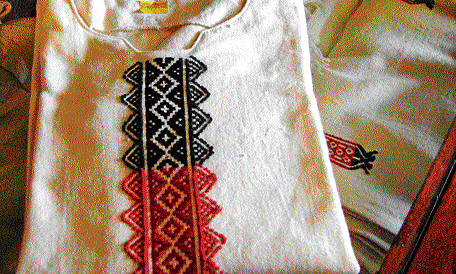
Toda embroidery has successfully adapted itself to contemporary demands, and is now visible not only on apparels, but on accessories as well. Brinda Suri gives us a flashback on this beautiful embroidery done by the Toda tribals of the Nilgiris, and its history.
The unstitched garment has always been a part of India’s apparel tradition. The sari, dhoti, lungi, veshti, dupatta, doru, phanek, etc., are part of the attractive array. An indispensable piece in that line-up is the shawl, which is not just a longish piece of fabric loosely draped over the shoulders, but a significant part of textile history. Every region in India creates a specific kind and each of these has a particular connotation.
Amongst the tribes across the country, the shawl is an evolved piece of clothing, and draping it is dictated by customs, season, celebration, etc. The Mangkotepsu, for example, can be worn only by the warriors of Nagaland’s Ao tribe, while the Tsungrem khim is exclusively meant for women of the state’s Yimchunger tribe. In Himachal, the Lingchay is woven and draped in a particular manner by women of Kinnaur, just as the Dhablo is worn with pride in Kutch, Gujarat.
Toda shawl
Of similar fashion is the Puthukuli, a trademark shawl belonging to the Toda tribe of the Nilgiris. A heavily embellished, thick and wide shawl, it’s worn alike by men and women. Customarily, it is part of daily dressing, and an absolute must-wear during ceremonial occasions. While most shawls across India are handwoven, the Puthukuli stands apart on account of being entirely embroidered. Its other noteworthy feature is the colour combination. The shawl is done in just two shades, red and black, with the base cream being the third hue. The colour code is one of the reasons it looks uber contemporary, the other being its liner pattern.
However, it was not always that these two shades were used, as recorded history speaks of the shawl being done only in the shade blue, a colour that’s very significant for the Todas, who believe in the forces of nature. Their embroidery in blue was a gratitude to the azure sky, the sapphire waters of the streams, and the cobalt hue mountains, the Nilgiris. The shift from blue to red-black is said to be the result of the winds of change brought by an urban population that began moving closer to their settlements and exposing them to other colours. Another thought puts this change in colours to the market demands of the West, with European settlers in the Nilgiris — particularly around the hills of Udagamandalam or Ooty, a region where Todas reside in large numbers — being the ones who promoted the shawl abroad, and gradually ensured the colour shift.
It’s the darning stitch with which the embroidered pattern is formed. The art of the Todas lies in the way they structure the stitches. So densely are these done that from afar, it lends the impression of a woven piece of fabric, with some patterns letting it appear as a printed textile.
Skillful work
The patterns are created without the aid of a wooden frame, and neither do they follow a pre-set design. It’s all done in an impromptu way by deft hands of Toda women, who, like their counterparts across the country, evoke a sense of admiration for the skills they exhibit.
The Puthukuli’s linear pattern wherein slender lines are off-set by broad bands, the tufted woollen threads, and the blend of red-black, all merge to create a very dramatic and opulent effect, making the shawl tremendously eye-catching.
A prepared shawl is about five metres in length and a little more than a metre in width. To get the desired width, two similar panels of equal size are embroidered and then stitched together, the reason there will always be a central ridge in an original Toda Puthukuli.
With the Todas being a pastoral community, the patterns on their shawls are inspired from nature and these are aesthetically juxtaposed with symbols of their belief in holy spirits. As observed in other regions, numerous folktales, prayers and songs also form part of the shawl design.
New trends
While the Puthukuli is all that the Todas embroidered once, their stitch-craft has now turned into an income-generating tool.
The survival of a handloom or handicraft depends on their easy adaptability to contemporary demands. Toda embroidery has found acceptance in the modern market with several non-governmental organisations, government schemes and textile designers collaborating towards popularising it. The Keystone Foundation, an NGO based in Kotagiri near Coonoor, is doing commendable work in this respect. The result is that Toda embroidery is now visible on apparels, as well as accessories. The striking range includes stoles, kurtis, pyjamas, table-linen, skirts, pants, bedspreads, spectacle cases, pouches, handbags, etc. Reassuringly, the colours remain black and red, with the forgotten blue also making a quiet comeback.